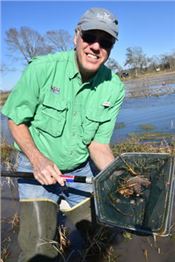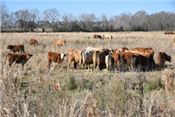AgCenter Assessing Freeze Damage To Crops, Livestock, Crawfish
BATON ROUGE, LA.
The LSU AgCenter is surveying agricultural producers to estimate damage totals resulting from last month’s freezing weather.
The recent freezing weather came just as farmers were getting back on their feet from last year’s disastrous hurricane season.
Kurt Guidry, LSU AgCenter economist, said he is compiling information for a report on how the freeze has affected agriculture, and he is sending out emails for a survey to make estimates.
Most of the losses he’s heard about involve livestock, particularly in north Louisiana. The storm came as cows were in the middle of calving season, and many newborns did not survive the cold.
Guidry also has gotten reports of damage to the horticulture industry, including significant damage in the Forest Hill area.
Michael Polozola, LSU AgCenter horticulturist, said some Forest Hill nurseries may have lost half their crop.
“Many had more damage from this storm than they had from the hurricanes last year,” he said.
Damages for some were minor, he said, but totaled into the millions of dollars for others.
He said his survey so far has shown more than 175 structures were damaged, and many more are still being reported. The first wave of damage occurred with heavy sleet that was followed by an ice storm.
Plants that weren’t contained in a structure were damaged.
“A lot of these plants were still in dormancy,” he said. “As they emerge, we’ll find out if they are able to sustain growth.”
Some growers were able to cover their plants, but even some covered plants didn’t survive, he said.
Polozola said nursery owners usually would spend February getting ready for the busy spring season. But they’ve had to divert their efforts to freeze preparations and, now, recovery.
Poultry losses were reported in Natchitoches, Arcadia and Farmerville.
“It’s a bad situation,” said Jason Holmes, LSU AgCenter regional livestock specialist based in Farmerville.
Several poultry facilities collapsed under the weight of ice and snow, killing thousands of birds, he said. Also, feed mill operations were frozen for several days, but deliveries could not be made anyway because of icy roads.
The losses include breeder chickens that produce birds for maintaining flocks or establishing new ones.
“When you start to lose breeders, that affects everything down the chain,” Holmes said.
He said it’s unlikely that consumer prices will be affected because the poultry industry in other states, such as Arkansas, is significantly larger and has a bigger effect on the marketplace.
“In the scheme of things, we’re a smaller player,” he said.
Holmes said many of the cattle in Louisiana are Brahman influenced, and they are more suited for hot weather than freezing temperatures.
“We’re not structured for calving in that weather,” he said.
Cattle producers had difficulty providing adequate water for their herds as troughs and ponds froze. Sledgehammers and shotguns came in handy to break ice, he said.
Vince Deshotel, LSU AgCenter regional livestock agent based in Opelousas, said calf losses were common. He lost two in his own herd.
The cold also was stressful on mature cattle.
“I see some stress in my cattle,” he said. “I’m hoping they’ll come out of it in a few days. They lost weight. There’s no question about it.”
Producers scrambled for five days to get hay to their animals, he said, and the cost of hay and supplements probably cost producers $25 to $50 per animal in extra expenses.
He said winter forages were damaged by the cold, but warm temperatures are helping grass recover.
Deshotel said Louisiana cattle operations aren’t structured for severe cold weather. Back when square hay bales were used, the bales were housed in sheds that could be used for feeding and shelter in bad weather, he said. Most of today’s larger round bales are stored outdoors, eliminating the need for sheds.
He said now may be a good time to wean fall calves to alleviate mother cows’ stress from providing milk.
The cold snap hit before planting season for most row crops. The impact to the state’s wheat crop should be minimal, Guidry said.
The cold forced crawfish to retreat into dormancy at the start of Lent, but the crop is expected to return to normal.
“The milder temperatures this coming week will make crawfish more active, and they will be more available,” said Mark Shirley, LSU AgCenter aquaculture specialist.
Kenneth Gravois, LSU AgCenter sugarcane specialist, is optimistic the damage is not too severe. Like most severe weather events, he said, it may take a while before a complete and accurate assessment can be made.
There could be a silver lining from the freeze, however. LSU AgCenter experts said at a recent crop consultants meeting that some diseases and insects that damage crops could be suppressed by the unusually cold temperatures. ∆

Mark Shirley, LSU AgCenter aquaculture specialist, finds a few crawfish in a pond near Abbeville days after the recent freeze.
Shirley expects the warm weather to revive crawfish, making them more plentiful for the marketplace. Unfortunately for producers, the freeze hit at the peak of the season.
Photo by Bruce Schultz/LSU AgCenter

Cattle feed in a Vermilion Parish pasture after the recent freeze. LSU AgCenter cattle experts advise producers that their animals may be stressed from enduring the severe cold weather.
Photo by Bruce Schultz/LSU AgCenter